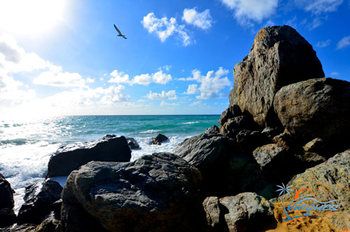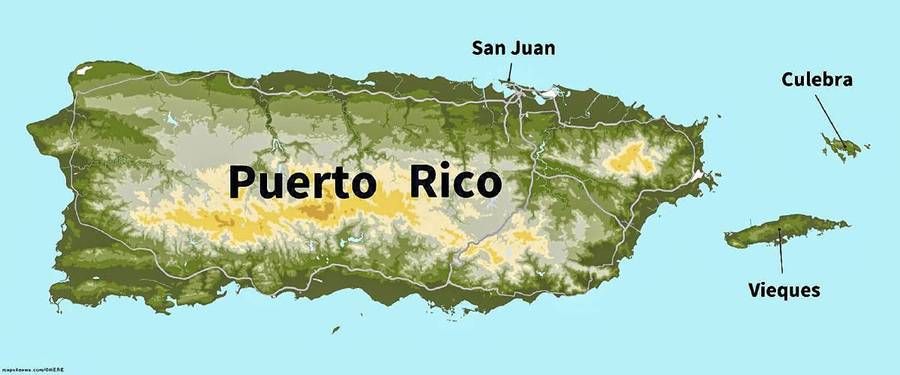
Publisher:
Bonnie King
CONTACT:
Newsroom@Salem-news.com
Advertising:
Adsales@Salem-news.com

~Truth~
~Justice~
~Peace~
TJP
Apr-29-2019 18:59

 TweetFollow @OregonNews
TweetFollow @OregonNews
Breaking the Grip of Militarism: The Story of Vieques
Dr. Lawrence Wittner, special to Salem-News.comThe fascinating story of how people unable to vote still ultimately earned a victory in our democracy.
 Image courtesy: Vieques.com |
(ALBANY, NY) - Vieques is a small Puerto Rican island with some 9,000 inhabitants. Fringed by palm trees and lovely beaches, it attracts substantial numbers of tourists. But, for about six decades, Vieques served as a bombing range, military training site, and storage depot for the U.S. Navy, until its outraged residents, driven to distraction, rescued their homeland from the grip of militarism.
Like the main island of Puerto Rico, Vieques—located eight miles to the east―was ruled for centuries by Spain, until the Spanish-American War of 1898 turned Puerto Rico into an informal colony (a “nonsovereign territory”) of the United States.
In 1917, Puerto Ricans (including the Viequenses) became U.S. citizens, although they continue to lack the right to representation in the U.S. Congress and to vote for the U.S. president.
During World War II, the U.S. government, anxious about the security of the Caribbean region and the Panama Canal, expropriated large portions of land in eastern Puerto Rico and on Vieques to build a mammoth U.S. naval base. As a result, thousands of Viequenses were evicted from their homes and deposited in razed sugar cane fields that the navy declared “resettlement tracts.”
The U.S. Navy takeover of Vieques accelerated in 1947, when it designated the base as a naval training installation and storage depot and began utilizing the island for firing practice and amphibious landings by tens of thousands of troops.
Expanding its expropriation to three-quarters of Vieques, the navy used the western section for its ammunition storage and the eastern section for its bombing and war games, while sandwiching the native population into the small strip of land separating them.
Over the ensuing decades, the navy bombed Vieques from the air, land, and sea and conducted military training exercises averaging 180 days per year. It also used the island for tests of biological weapons.
Naturally, for the Viequenses, this military domination created a nightmarish existence.
“When the wind came from the east, it brought smoke and piles of dust from their bombing ranges,” one resident recalled.
“They’d bomb every day, from 5 am until 6 pm. It felt like a war zone. You’d hear ...eight or nine bombs, and your house would shudder. Everything on your walls ...would fall on the floor and break,” and “your cement house would start cracking.”
In addition, with the release of toxic chemicals into the soil, water, and air, the population began to suffer from dramatically higher rates of illnesses.
Eventually, the U.S. Navy determined the fate of the entire island, including the nautical routes, flight paths, aquifers, and zoning laws in the remaining civilian territory, where the residents lived under constant threat of eviction.
In 1961, the navy actually drafted a secret plan to remove the entire civilian population from Vieques, with even the dead slated to be dug up from their graves. But U.S. President John F. Kennedy blocked the plan from implementation.
Long-simmering tensions between the Viequenses and the navy boiled over from 1978 to 1983. In the midst of heightened U.S. naval bombing and stepped up military maneuvers, a vigorous local resistance movement emerged, led by the island’s fishermen.
Activists engaged in picketing, demonstrations, and civil disobedience―most dramatically, by placing themselves directly in the line of missile fire, thereby disrupting military exercises.
But this first wave of popular protest, involving thousands of Viequenses and their supporters throughout Puerto Rico and the United States, failed to dislodge the navy from the island. In the midst of the Cold War, the U.S. military clung tenaciously to its operations on Vieques. Also, the prominence in the resistance campaign of Puerto Rican nationalists limited the movement’s appeal.
In the 1990s, however, a more broadly-based resistance movement took shape. Begun in 1993 by the Committee for the Rescue and Development of Vieques, it accelerated in opposition to navy plans for the installation of an intrusive radar system and took off after April 19, 1999, when a U.S. navy pilot accidentally dropped two 500-pound bombs on an allegedly safe area, killing a civilian.
Rallying behind the demand of Peace for Vieques, this massive social upheaval drew heavily upon the Catholic and Protestant churches, as well as upon the labor movement, celebrities, women, and university students. Hundreds of thousands of Puerto Ricans participated, with some 1,500 arrested for occupying the bombing range or for other acts of nonviolent civil disobedience.
When religious leaders called for a March for Peace in Vieques, some 150,000 protesters flooded the streets of San Juan in what was reportedly the largest demonstration in Puerto Rico’s history.
Facing this firestorm of protest, the U.S. government finally capitulated. In 2003, the U.S. Navy not only halted the bombing, but shut down its naval base and withdrew from Vieques.
Despite this enormous victory for a people’s movement, Vieques continues to face severe challenges today. These include unexploded ordnance and massive pollution from heavy metals and toxic chemicals that were released through the dropping of an estimated trillion tons of munitions on the tiny island.
As a result, Vieques is now a major Superf und Site, with cancer and other disease rates substantially higherthan in the rest of Puerto Rico. Also, with its traditional economy destroyed, the island suffers from widespread poverty.
Nevertheless, the islanders, no longer hindered by military overlords, are grappling with these issues through imaginative reconstruction and development projects, including ecotourism.
Robert Rabin, who served three jail terms for his protest activities, now directs the Count Mirasol Fort―a facility that once served as a prison for unruly slaves and striking sugar cane workers, but now provides rooms for the Vieques Museum, community meetings and celebrations, and Radio Vieques.
Of course, the successful struggle to liberate the island from the burdens of militarism also provides a source of hope for people around the world. This includes the people in the rest of the United States, who continue to pay a heavy economic and human price for their government’s extensive war preparations and wars.
 Image: Amherst Bulletin |
 |
Articles for April 28, 2019 | Articles for April 29, 2019 | Articles for April 30, 2019





Quick Links
DINING
Willamette UniversityGoudy Commons Cafe
Dine on the Queen
Willamette Queen Sternwheeler
MUST SEE SALEM
Oregon Capitol ToursCapitol History Gateway
Willamette River Ride
Willamette Queen Sternwheeler
Historic Home Tours:
Deepwood Museum
The Bush House
Gaiety Hollow Garden
AUCTIONS - APPRAISALS
Auction Masters & AppraisalsCONSTRUCTION SERVICES
Roofing and ContractingSheridan, Ore.
ONLINE SHOPPING
Special Occasion DressesAdvertise with Salem-News
Contact:AdSales@Salem-News.com
Terms of Service | Privacy Policy
All comments and messages are approved by people and self promotional links or unacceptable comments are denied.
[Return to Top]
©2025 Salem-News.com. All opinions expressed in this article are those of the author and do not necessarily reflect those of Salem-News.com.